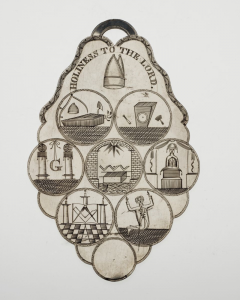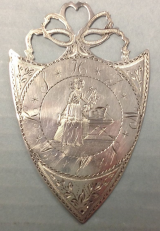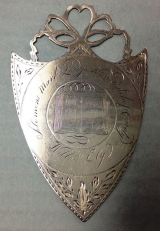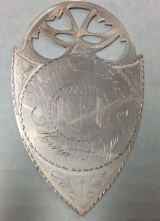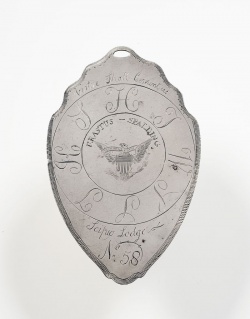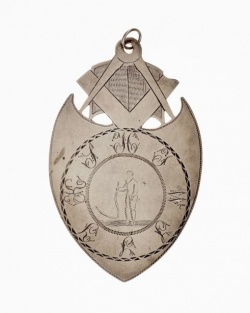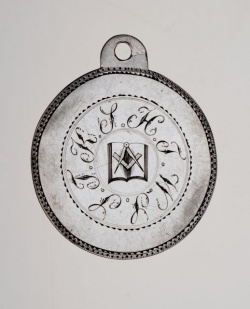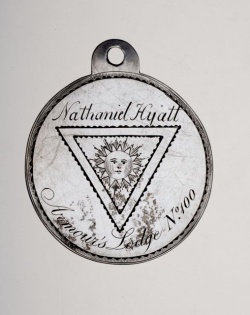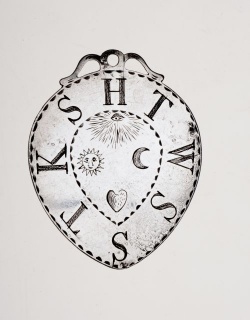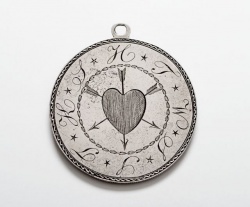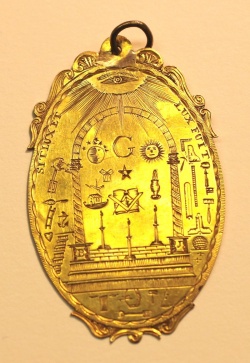En: Mark Medals
James Higgins’ Mark Medal
Source: Scottish Rite Masonic Museum & Library
A year ago the Scottish Rite Masonic Museum and Library was lucky enough to receive a give of a collection of chapter pennies and badges, mostly dating from the early 1900s. Mixed in with the comparatively modern tokens was an engraved silver mark medal that belonged to James Higgins, made in the 1810s or 1820s (below, at left).
As regular blog readers know, these individually commissioned badges can be fascinating.This one sparked our interest because of its intriguing shape and similarity to another in the collection: a gilded and engraved crafted for Henry Brayman, a member of David’s Royal Arch Chapter (at left).
Both of these medals were cut in an interesting lobed form. One side is engraved with the owner’s name and chapter, the other bears the Royal Arch motto “Holiness to the Lord,” a mitre and eight circles (both below, at left). Within each circle the engraver illustrated selections of Masonic symbols or scenes that relate to the Mark Master degree. For example, the circle on the upper right contains images of a keystone, chisel and mallet—all symbols of the Mark Master degree.The circle at the lower left encloses three candles, an open Bible, a square and compasses—the lesser and greater lights of the lodge. Comparison of the symbols and scenes engraved within the circles points to a common inspiration for these vignettes, although we don’t yet know what it is. Each medal also features an integrated hanging loop at its top, as well as similarly styled script letters in the mnemonic “HTWSSTKS” separated by simple flowers, and a trailing vine embellishing the top edge of the medal by the loop. Together, the similarities between the two medals suggest they may be the work of the same engraver.
The man who owned the gilded medal, Henry Brayman, belonged to David’s Chapter No. 34 and St. Paul’s Lodge in Auburn, New York. He may have been the Henry Brayman (1791-1853) who lived in Aurelius and later Buffalo, New York. James Higgins owned the silver medal. He is likely the James Higgins (1766-1827) who was born in Connecticut but later lived in Hamilton, New York, where he worked as a cabinetmaker, hotel keeper and tanner. He was a member of Hamilton Lodge, No. 121, as well as Cyrus Royal Arch Chapter No. 50 of Eaton, New York. Brayman selected a personal mark of a square and awl and had these the symbols engraved on his medal along with his name. James Higgins never had his mark incised on his badge, for reasons we can only speculate about. Hopefully ongoing research will uncover more about these expertly crafted and interestingly decorated medals. If you have any insights to share, please let us know in a comment.
Many thanks to Tom Savini, Director, Chancellor Robert R. Livingston Masonic Library, Grand Lodge of New York.
Mark Medals from Dutchess County, New York
As always, we are excited about some of our recent acquisitions! Just a few weeks ago, the Scottish Rite Masonic Museum & Library was able to add two beautifully engraved mark medals to our growing collection. These two medals are each interesting on their own. They also prompted intriguing questions when viewed side by side.
In previous posts we have discussed other mark medals in the collection. These engraved badges feature a specially selected symbol—often related to Freemasonry or the owner’s profession—sometimes along with the owner’s name and his lodge’s name and location. These two shield-shaped mark medals are embellished with intricate pierced tops. These carefully made decorative elements were designed to allow the owner to wear his badge around his neck, suspended from a ribbon.
Each of these medals bears an owner’s name and Masonic lodge. William Ely (dates unknown) belonged to Solomon’s Mark Lodge in Poughkeepsie, New York and commissioned the medal with top pierced to look like a ribbon tied in a bow (see at left). Ely chose a complicated symbol, or mark, for himself: a young woman holding a vine in her left hand and a set of scales in her right. She stands next to a table or counter, decorated with a square and compasses. A mortar and pestle and a bottle sit on it, possibly suggesting apothecary work. The other medal belonged to John Dutcher (dates unknown), a member of Hiram Lodge No. 27 in Amenia, New York. His mark, surrounded by the mnemonic associated with the mark degree and a circle enclosing 15 different Masonic symbols, was a top hat and what looks to be a gavel (see image below at right)—symbols often associated with the office of lodge master.
Ely’s lodge, Solomon’s Lodge of Poughkeepsie, first chartered in 1771, had several numbers over the years it met—1, 56 (the number on this medal and used by the lodge from 1797-1800), 5 and 6. Members are thought to have established a mark lodge, called Solomon’s Mark Lodge, during the late 1700s. Hiram Lodge No. 27—first founded in 1793 as Payne Lodge, called Hiram Lodge after 1797—received a dispensation for a mark lodge in 1810. The Grand Chapter approved the charter for Hiram Mark Lodge No. 65 in 1811.
The Ely and the Dutcher medals are both shield-shaped with different pierced elements. A close look at the sides of the two medals that bear Ely’s and Dutcher’s names show like symbols—an open Bible with a corner of a page folded back—engraved in a similar style (see images at left and below). The image is embellished with the same flourishes at the top and bottom of the open volume. This and other similarities shared by the medals suggests a question: did the same craftsman design and engrave these medals? Hopefully, with further research, we will learn more about these medals' owners and makers. If you have any ideas or insights, be sure to leave a comment below!
References:
Catalog notes, Minute Book, Solomon’s Lodge No. 1, Poughkeepsie, New York (1771-1852), Chancellor Robert R Livingston Masonic Library of the Grand Lodge of New York.
Compiled by Gary L. Heinmiller, Craft Freemasonry in Dutchess County, New York, (Onondaga & Oswego Masonic Districts Historical Societies, March 2010).
Proceedings of the Grand Chapter of Royal Arch Masons of the State of New York, Volume 1. 1798-1853. (Buffalo, New York: Grand Chapter, 1871).
Erastus Spalding's Mark Medal
Every now and then, a researcher’s inquiry will inspire us to take a closer look at an object in the collection—recently this mark medal made for Erastus Spalding (1775-1830) of Scipio, New York. It was added to the collection of the Scottish Rite Masonic Museum & Library a few years ago.
On his medal, formed out of thin sheet silver in the shape of a plumb bob, Spalding commissioned a craftsman to engrave text and symbols. On one side of the medal (shown on the left), Spalding had several Masonic symbols along with a mallet and keystone, emblems related to the mark degree, engraved. On the other side of the medal (shown on the right), for his mark--the symbol he chose to represent himself--Spalding selected elements taken from the Great Seal of the United States. The seal, officially adopted in 1782, featured an eagle supporting striped shield. In one talon the eagle grasps an olive branch, representing peace; in the other the eagle grips arrows, to signify war. From the eagle's beak a banner decorated with the motto E Pluribus Unum (out of many, one) flies. Spalding also directed that a Masonic motto, “Virtue Shall Cement Us,” be incised on the medal, as well as the name of his lodge, Scipio Lodge No. 58.
Born in Connecticut, Spalding first came to Scipio with his parents and siblings in the late 1780s or early 1790s. Spalding’s father, Oliver (1739-1795) served in the Revolutionary War. Grants of land made to former Revolutionary War soliders may have drawn his family to the area. Erastus and some of his brothers seem to have owned land in Scipio after their father’s death (you can see their names near plot 138 on this map). In developing their new community, area men established Scipio Lodge No. 58. Chartered in 1797, the lodge counted Spalding among its early members. He served on a committee that organized the construction of a new lodge building after an 1805 fire and as Junior Warden in 1807. By the early 1810s, Spalding and his family left Scipio. They eventually lived in Charlotte, Rochester and, later, Lockport, New York.
Intriguingly, Scipio Masons did not establish their Royal Arch Chapter--Aurora Chapter No. 64--until 1819, several years after Erastus Spalding had moved. Further research may uncover information about when and where Spalding took the mark degree. Regardless, the text and symbols Spalding had engraved on his medal point to the pride he felt as a Mason and as a citizen of the new United States.
Photographs:
Mark Medal, 1800-1820. New York. Museum Purchase, 2011.021. Photos by David Bohl. References:
A Short History: Scipio Lodge No. 110 (Ann Arbor, Michigan: Edward's Brothers, Inc.), 1940.
Samuel J. Spalding, Spalding Memorial: A Genealogical History of Edward Spalding of Massachusetts Bay and His Descendants, (Boston: Alfred Medge & Son, Printers), 1872.
Occupation-Related Symbols on Mark Medals
Some time in the early 1800s, Cornelius P. Vrooman (1784-ca. 1821), a member of Middleburgh Mark Lodge, Middleburgh, New York, commissioned this silver shield-shaped medal. It is a recent addition to the Scottish Rite Masonic Museum and Library's collection. The maker incorporated important Masonic symbols into the form of Vrooman’s medal--the square, compasses and open Bible at the top of the shield. Engraved details like the print on the Bible pages and the outline of the compasses’ legs help delineate the symbols. On one side of the medal (illustrated to the left), the craftsman detailed Vrooman’s name and the name of his lodge as well as a keystone marked with the mnemonic associated with the Mark Master degree, HTWSTTKS. On the other side (illustrated below), within the border of a circle, the engraver incised the mnemonic in ornamental script. The circle contains Vrooman’s mark, a man with a scythe.
As noted in previous posts, the emblem selected by the owner of a mark jewel represented something meaningful to him. Mark Masons chose different kinds of emblems, from patriotic and Masonic symbols, to initials or family crests. In addition, many Mark Master Masons decided on representations of their occupation or profession as their personal symbol. Vrooman’s emblem appears to be one such, the man and a scythe likely denoting a farmer. If an anecdote retold in a 1870s gazetteer can be believed, Vrooman was indeed a farmer. In a description of the Vrooman family, the gazetteer's author noted that the four Vrooman brothers “were remarkable for their strength.” As an example, the author related that Cornelius “was accustomed to carry one or two bags…on his shoulders, to favor his horse, when going to Albany with a load of wheat.”
Another example of an occupation-related mark can be found in the record for Rev. Alpheus Harding (1780- 1869), whose mark of a lamb and cross spoke to his job as a religious leader. This mark is noted in the mark book kept for King Hiram Royal Arch Chapter of Greenwich, Massachusetts. (You can read previous posts about this beautifully illustrated record and its illustrator.) Other examples of symbols connoting professions appear in the late 1700s and early 1800s records of Washington Royal Arch Chapter of Middletown, Connecticut. Members of a mark lodge associated with the chapter often dictated a motto to go with their symbols, leaving a clue as to what their choice of mark represented to them. For example, William Hall (dates unknown), recorded a knife as his mark and his motto as “amputation,” suggesting he might have been a surgeon. Charles Magill (dates unknown) selected a brig as his mark and, for his motto, “navigation.” His fellow member, Noadiah Hubbard, Jr. (b. 1765), accompanied the motto “husbandry” with a plough for a mark. Another member, recorded in the 1820s, claimed a trowel as his mark along with the motto, “the implement of my profession.” Taken together these occupational marks offer an intriguing glimpse into the professional landscape of early 1800s mark lodges.
References:
James R. Case, August W. Von Hagen and Oswald H. Johnson, Early Records of Washington Chapter (6) Royal Arch Masons, of Middletown, Connecticut, Reproduced by Xerography on the 175th Anniversary (Hartford, Connecticut: Bond Press, Inc.), 1958.
Hamilton Child, Gazetteer and Business Directory of Schoharie County, New York, for 1872-1873. (Syracuse, New York: Hamilton Child), 1872, p. 115.
Photo credits:
Mark Medal, 1807-1821. Probably New York. Museum Purchase, 2013.054.3. Photos by David Bohl.
Nathaniel Hyatt's Mark Medal
As regular readers of the Scottish Rite Masonic Museum and Library blog know, we love to talk about new acquisitions. Recently we were lucky to add another intriguing mark medal to our collection, this one likely made for Nathaniel Hyatt (1781-1873) of New Castle, New York. You can read previous posts discussing mark medals crafted for Frederick Phile, Ezra Bennet and Ezekiel Bascom.
Hyatt’s medal is a plain circle, about two inches in diameter. A hole punched in a sturdy tab at the top of the medal likely accommodated a loose ring so the silver disk could be suspended from a ribbon. On both sides of the medal, simple engraved patterns decorate the outer edge. On one side, pictured to the left, the mnemonic HTWSSTKS, engraved in script letters, surrounds Hyatt’s personally selected mark, a square and compasses on top of an open Bible. The other side of the disk, illustrated below at right, bears Hyatt’s name, the name of a Masonic lodge--Armour’s Lodge No. 100--and a sun with a face enclosed by a delta.
Information about Armour’s Lodge No. 100 or any mark lodge associated with it, is scarce. Proceedings of the Grand Lodge of New York, note that Armour Lodge, located in Rye, New York, received a warrant in 1803. Members named their organization after one of the petitioners, Samuel Armour (dates unknown). The lodge made its last return to the Grand Lodge in 1827. In that same year, a New York City directory listed Armour Lodge as meeting in Sawpits, a village of Rye. By 1834 the lodge had forfeited its charter. (Later New York Masons revived the name for a lodge in Port Chester, Armour Lodge No. 186, founded in 1850.) Proceedings of the Grand Chapter of New York record that in 1818 members of the Armour Lodge submitted a “…petition for Armour Mark Lodge, No. 100, [which] was not proper either in form, address or recommendation, and should be returned.” From the proceedings, it does not seem that the petition was re-submitted. Although the records in the Grand Chapter Proceedings are not clear, Hyatt’s medal, bearing the name of the lodge, suggests Armour Lodge members eventually established a mark lodge.
The 1830 census lists a Nathaniel Hyatt as a resident of Rye, New York, with a family of seven children. This man likely owned the medal and is quite possibly the man listed in an online resource, Craft Masonry in Westchester and Putnam Counties, New York, as a member of Hiram Lodge No. 72 in Mount Pleasant, New York, along with his father, Abraham Hyatt (1747-1830). Abraham Hyatt signed the original petition for the lodge in 1796. Nathaniel Hyatt (son of Abraham) and his wife, Amy Van Wart Carpenter Hyatt (ca. 1786-1848) were Quakers who married and worshiped in Chappaqua, New York. Both born in New Castle, New York; they had at least nine children.
Hopefully, further research will add to our understanding of the commissioner of this medal, his Masonic participation and the lodges he belonged to. In the meantime, Hyatt’s handsome silver token offers enduring evidence of Armour Lodge No. 100 and one of its members.
Photo credits:
Mark Medal, 1803-1827. Probably New York, Museum Purchase, 2013.054.2. Photos by David Bohl.
References:
Compiled by Gary L. Heinmiller, Craft Masonry in Westchester and Putnam Counties, New York. (Onondaga & Oswego Masonic Districts Historical Societies, May 2011).
Harold W. Jack, Mark Lodges of New England. (Boston, Massachusetts: The Massachusetts Chapter of Research, 1976).
Proceedings of the Grand Chapter of Royal Arch Masons of the State of New York, Volume 1. 1798-1853. (Buffalo, New York: Grand Chapter, 1871).
Transactions of the Grand Lodge of Free and Accepted Masons of the State of New York, 1816-1827. (New York: Masonic Publishing and Furnishing Co., 1880).
Mark Medal from Connecticut
When it rains it pours! As noted in recent and past posts, we’ve got a soft spot for the personalized badges that some Masons commissioned for themselves in the first decades of the 1800s. We are excited to have just added a wonderful Connecticut example to our collection at the Scottish Rite Masonic Museum and Library.
This silver medal belonged to Ezra Bennet (also spelled Bennitt and Bennett). Born in 1776 or 8, Bennett appears to have been a life-long resident of Weston, Connecticut. There he married Esther Godfrey (dates unknown) in 1796. Counted in the 1810, 1820 and 1830 census, Bennet was probably a farmer. He died in 1831 and was buried in Bridgeport, Connecticut. Records at the Grand Lodge of Connecticut note him as raised at Ark Lodge No. 39 of Redding (now in Danbury) in 1802. A local history names Ezra Bennet as a member of Lynch Chapter No. 8 and Heron Mark Lodge, along with his brother, Platt (b. 1770) and William Bennitt (dates unknown), likely another relation.
First established in 1801, Lynch Chapter No. 8 and Heron Mark Lodge met in Weston and Redding until 1828. Although located in Connecticut, where Royal Arch Masons first organized a Grand Chapter in 1798, Lynch Chapter No. 8, received its charter from the Grand Chapter of New York. Interestingly, this charter is not named in the proceedings of the Grand Chapter of New York. Joseph Wheeler, however, notes the source of Lynch Chapter No. 8’s charter in his history of Royal Arch Freemasonry in Connecticut. Masons in New York founded numerous Mark Lodges—one scholar estimated over 80 through 1809—many warranted by the Grand Chapter of New York. A great number of these New York Mark Lodges were independent—not affiliated with a Royal Arch Chapter. Connecticut brethren also founded Mark Lodges—some scholars believe the one formed in 1783 at Middletown, Connecticut, was the first in the United States—but only a few. Unlike their colleagues in New York, the Grand Chapter of Connecticut did not charter or administer independent Mark Lodges. A few years after its founding, Lynch Chapter found a home with the Grand Chapter of Connecticut, when that group admitted the chapter “into full fellowship and unity.”
The original members of Lynch Chapter No. 8 named their group after a member, Francis Lynch (dates unknown). In the same spirit, members gave the name of another locally-influential citizen, William Heron (1742-1819), to their Mark Lodge. In addition to serving as the first Master of Ark Lodge in Redding, Heron was active in local and state government and holds the intriguing distinction of having likely been a spy for both sides during the American Revolution.
Unfortunately, we don’t know too much about Erza Bennet. This medal, however, may give us a glimpse of what he valued. Mark medals come in many shapes. The most popular ones were shields, hearts, circles and keystones. Bennet’s medal was crafted in an uncommon teardrop shape that probably represented a plumb bob—the weight at the of a plumb line. In Freemasonry, a plumb or plumb rule, a tool that helps the user assess verticality, is a symbol of uprightness, rectitude or truth. A level, which also incorporated a plumb bob, represented equality. On one side of the this medal, the engraver cut Bennet’s name in a flowing banner decorated by stylized flowers and vines, similar in style to the engraving Peter Rushton Maverick (1755-1811) executed on the medal he made for Frederick Phile. On the other side of the Bennet medal the engraver pictured four symbols, an all-seeing eye, a sun, a crescent moon and a heart, all within the mnemonic HTWSSTKS. Placed inside the mnemonic, together these symbols formed the mark Bennett chose for himself. This mark likely recalled some of the lessons he learned in the lodge. Ritualist (and fellow Connecticut resident) Jeremy Cross (1783-1860) included an illustration featuring those symbols, along with a comet and stars, in his handbook for Freemasons, The True Masonic Chart and Hieroglyphic Monitor. With the illustration, first published in 1819, Cross noted this interpretation of the symbols for his readers: “…although our thoughts, words and actions, may be hidden from the eyes of men, yet that All-Seeing Eye, whom the Sun, Moon, and Stars obey, and under whose watchful care even Comets perform their stupendous revolutions, pervades the inmost recesses of the human Heart, and will reward us according to our merits.”
If you have any insights or questions about this recent addition to the collection, please leave us a comment.
Photo credit:
Mark Medal, 1801-1828. Probably Connecticut, Museum Purchase, 2013.054.1. Photos by David Bohl.
References:
Case, James R., “William Heron,” The Case Collection of Masonic Notables (Fulton, Missouri: Missouri Lodge of Research, 1984).
Cross, Jeremy L., The True Masonic Chart and Hieroglyphic Monitor… (New Haven, Connecticut: Amos Doolittle, 1820). Reprinted by the Texas Lodge of Research, 1984.
Hurd, D. Hamilton, History of Fairfield County, Connecticut (Philadelphia, Pennsylvania: J. W. Lewis and Co., 1881).
Jack, Harold W., Mark Lodges of New England (Boston, Massachusetts: The Massachusetts Chapter of Research, 1976).
Wheeler, Joseph K., Records of Capitular Masonry in the State of Connecticut (Hartford, Connecticut: Press of Wiley, Waterman and Eaton, 1875)
Frederick Phile's Maverick Mark Medal
Here at the Scottish Rite Masonic Museum and Library, we are big fans of the personal medals and badges some Masons had made for themselves in the late 1700s and early 1800s. You may have read posts about the mark medal that belonged to Ezekiel Bascom and an associated mark book or saw the post discussing a gold Masonic medal owned in Connecticut. Although the museum counts many personal Masonic medals in its collection, we are always on the lookout for new objects to help us tell the story of American Freemasonry. A few months ago we were thrilled to add a mark medal made for Frederick Phile of Holland Mark Lodge and engraved by "Bror. Maverick" to the collection.
Frederick Phile (ca. 1740-1793) of Philadelphia likely commissioned the medal when he received the Mark Master degree at Holland Mark Lodge in New York City, sometime between 1788, when members of Holland Lodge No. 8 established Holland Mark Lodge and 1793, when Phile died. Records detailing Phile’s Masonic activity are sketchy, but he seems to have taken the Entered Apprentice degree at Lodge No. 2 (Moderns), in Philadelphia in 1760. He worked as a physician until around 1770, when he took on the duties of naval officer for the Port of Philadelphia; a position Phile held, in different capacities, on and off, until his death. During the Revolutionary War, Phile, a German-born naturalized citizen of Great Britain, served as a surgeon for a Pennsylvania battalion. Although Holland Mark Lodge drew most of its membership from Holland Lodge, occasionally out-of-town Masons, like Phile, who had not taken the Mark Master degree elsewhere would pay the fee (24 shillings in 1791) and receive the degree at Holland Mark Lodge. In 1791, for example, the lodge granted the mark degree to Masonic travelers from France and Rhode Island.
As part of the ritual for the Mark Master degree, the initiate chose a distinct mark or emblem. The lodge secretary noted this unique mark in his records. For his emblem Phile selected a heart over three crossed arrows. This symbol doubtless held meaning for Phile, but we have not been able to identify what this symbol might have represented. Holland Mark Lodge required that, "Every member shall furnish himself with a Mark which shall be of Silver, with the Name of the Lodge engraved thereon." As described in a research note published in the Transactions of the American Lodge of Research, from 1788 to about 1800, Holland Mark Lodge members recorded their marks with both a written description and an impression of their engraved mark in the lodge’s minute book.
Of the over thirty mark medals in the museum’s collection, only Phile’s is signed by an engraver. The "Bror Maverick" who incised his name under Phile’s on this silver disk is thought to be Peter Rushton Maverick (1755-1811), a member of both Holland Lodge and Holland Mark Lodge. Phile’s medal is one of six known that were crafted for members of Holland Mark Lodge. One, also signed by Maverick, is at the Smithsonian Institution; the museum at the Grand Lodge of England holds another and two form part of a private collection. The library of the Grand Lodge of Iowa counts Peter Rushton Maverick’s own 1789 mark medal as part of its collection. A history of Holland Lodge relates that Peter Rushton Maverick, who joined the lodge in 1789, cut a seal for Holland Lodge the year before. He also engraved maps, bookplates and Masonic certificates, among other things. The museum holds a certificate, estimated to date from around 1790, for Alexandria-Washington Lodge No. 22 and attributed to Peter Rushton Maverick, in its archives. We are now glad to be able to include another example of Maverick’s work in our collection.
Photo credits:
Mark Medal, 1788-1793. Engraved by Peter Rushton Maverick (1755-1811), New York, New York. Museum Purchase, 2013.019. Photos by David Bohl.
References:
Balestier, Joseph N., Historical Sketches of Holland Lodge (New York, New York: Holland Lodge No. 8, 1862), 40-41, 156
Tows, Ferrars, H., "The Holland Mark Lodge Book," Transactions of the American Lodge of Research, Vol. III, No. 2, 1939-1940, 404-5
Sesquicentennial Commemorative Volume of Holland Lodge No. 8 (New York, New York: Holland Lodge No. 8, 1938), 21-24.
Newell, Aimee E., Hilary Anderson Stelling and Catherine Compton Swanson, Curiosities of the Craft: Treasures from the Grand Lodge of Massachusetts Collection (Boston and Lexington, Massachusetts: Grand Lodge of Masons in Massachusetts and Scottish Rite Masonic Museum and Library, 2013), 101, 113.
Sachse, Julius F., Old Masonic Lodges of Pennsylvania "Moderns" and "Ancients" 1730-1800, (Philadelphia: Grand Lodge of Pennsylvania, 1912-1913), Vol. 1, 76.
A 1794 Masonic Medal from New London
In 1794 Freemasons in New London, Connecticut, had much to celebrate. After several years of inactivity, Union Lodge (now Union Lodge #31) received a dispensation from the newly organized Grand Lodge of Connecticut. As a sign of enthusiasm, one lodge member had this attractive gold medal manufactured and engraved.
Around the time this medal was crafted, Masons on both sides of the Atlantic commissioned personal badges or medals made out of precious metals to wear to lodge meetings and at processions. Unlike jewels of office that were owned by a lodge, these badges belonged to individual Masons. Men wore them as a sign of their connection with Freemasonry, its ideals and place in the community. Engraved with Masonic symbols and often the owner’s name and initiation date, these badges linked, in an enduring way, Masons with the organization they valued.
Many of these badges, sometimes called chapter medals, although engraved by different craftsmen and owned by men in different parts of the country, share similarities in shape, size and iconography. Decorated on both sides, this small oval medal—about 1 ½ inches long—bears a Latin motto, multiple Masonic symbols, the owner’s initials, J. S. (or possibly J. P.), and the year, 1794, with the words, “Member of Union Lodge N. London.” This medal also features Masonic symbols such as an open bible, square and compasses, various working tools, an all-seeing eye, a dove and ark, pillars, suns, moons, stars, and a coffin; symbols associated with Freemasonry’s first three degrees. On the medal the engraver also illustrated symbols related to Royal Arch Freemasonry.
New England chapter medals emerged from an English practice. As early as 1776 the rontispiece of reverse London-printed Masonic expose, Jachin & Boaz, or An Authentic Key to the Door of Free Masonry, showed an engraved medal featuring many of the same symbols as seen on this and other chapter medals. Text within the publication also described the badges noting that: “These medals are usually of silver…on the reverse of these medals…some even add to the emblems other fancy things that bear some analogy to Masonry.” American engravers might have used illustrations in Jachin & Boaz or other publications as models for their depiction of Masonic symbols. As well, American publishers issued versions of Jachin & Boaz that opened with the same frontispiece as the British editions. Additionally, small emblems similar to this one were easily carried when their owners traveled. One craftsman might copy or seek inspiration from another engraver’s work; be it a medal, jewel, a certificate or Masonic apron. Residents of New London, a seaport, likely had the chance to socialize and do business with Masons from other parts of the country and the world.
So far, research has not confirmed who fired owned this medal, but Joseph Skinner, a member of Union Lodge who joined on December 23, 1794, is a good candidate. Although small, this carefully engraved medal, because it was made of gold, a scarce and costly material, was not ordered or worn casually. Whoever commissioned and wore this medal took pride in his association with Freemasonry.
Sources:
John D. Hamilton, The Material Culture of the American Freemasons. Museum of Our National Heritage, Lexington, Massachusetts, 1994. pp. 121-133, 140-142.
Barbara Franco, Masonic Symbols in American Decorative Arts. Scottish Rite Masonic Museum of Our National Heritage, Lexington, Massachusetts, 1976. pp. 25-26.
Many thanks to John Birdsall of Union Lodge #31.
Photo credits:
Medal, ca. 1794. Scottish Rite Masonic Museum and Library, Museum Purchase, 2000.059.7b.
See also
- En:Scottish Rite
- AASR in Deutschland
- Hochgrade in Österreich
- Schottische Maurerei
- Schottischer Ritus Kathedrale
- Schottischer Ritus Emblematik
- Besuchsabkommen AASR
- Alphonse Mucha
- Etienne Morin
- Kaiser vom 0sten und Westen
- Alexandre Françcois Auguste Grasse-Tilly
- Albert Pike
- Morals and Dogma
- Fiat Lux
- Logen in der Schweiz
- Franz Carl Endres
- Albert Pike Lodge 1067
- Schottischer Ritus
Links
- AASR Germany, High Council https://aasr.net/index.php?id=37
- Ohio Freemason bei Youtube http://www.youtube.com/user/cadyer72
- Website der Urania Lodge No. 311 of Plain City, Ohio https://urania311.org/


![Mark Medal made for Henry Brayman, ca. 1818-ca. 1830, New York. Museum Purchase, 2008.010. Photograph by David Bohl.]]](/images/thumb/3/3f/Mark_Medals.png/240px-Mark_Medals.png)
![Mark Medal made for Henry Brayman, ca. 1818-ca. 1830, New York. Museum Purchase, 2008.010. Photograph by David Bohl.]]](/images/thumb/0/0f/BackMedal.png/240px-BackMedal.png)
